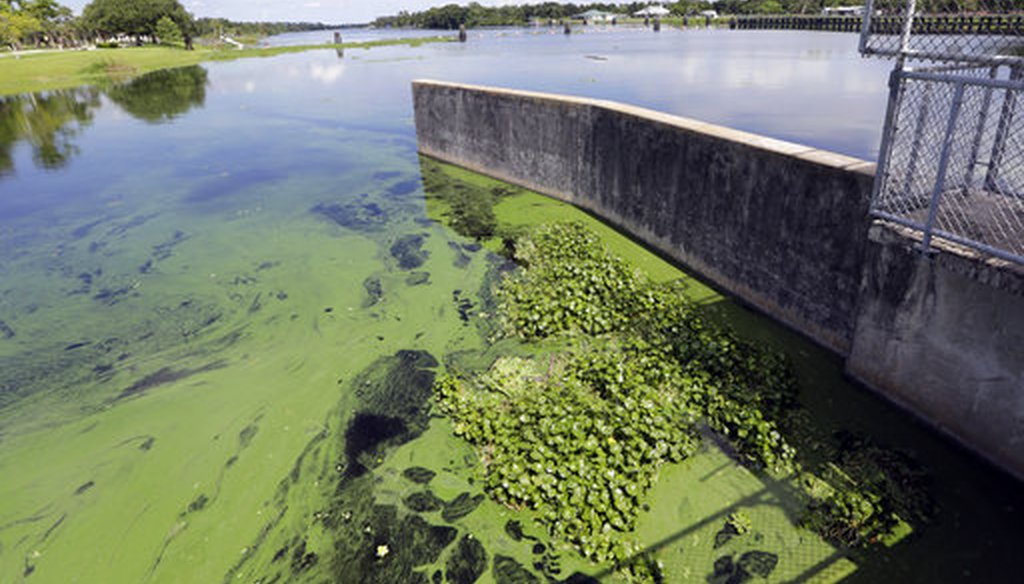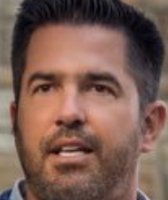Stand up for the facts!
Our only agenda is to publish the truth so you can be an informed participant in democracy.
We need your help.
I would like to contribute

An algae bloom is on the Caloosahatchee River at the W.P. Franklin Lock and Dam, Thursday, July 12, 2018, in Alva, Florida. (APP
A blue-green algae bloom is covering most of Lake Okeechobee, filling it with slimy toxic goop. The pollution has grabbed headlines nationwide and prompted political candidates to slime each other.
When the massive lake fills after a rain and threatens to flood the surrounding communities, the U.S. Army Corps of Engineers releases water. The discharges send the algae bloom into connecting waters in the St. Lucie and Caloosahatchee rivers.
The algae blooms have drawn health warnings and a declaration of emergency in seven counties. They’ve hurt waterside businesses; one businessman held a mock funeral for his kayak rental operation. But even regular businesses are affected; a magazine closed its Stuart office because it suspected the algae bloom was making staffers sick with respiratory and other problems.
The causes of the bloom and what to do about it have become issues in Florida’s political races, including the Republican primary for governor.
During an Aug. 8 debate, the moderator asked U.S. Rep. Ron DeSantis and Agriculture Commissioner Adam Putnam if they would increase funding for the state to inspect septic tanks to help solve the algae bloom.
"I don’t think the septic tanks are the core issue," DeSantis replied. "I know there has been stuff put out on that I think that was funded by industry sources. To me the problem is is that you are putting all the phosphorus into Lake Okeechobee. When the lake rises, they have the Army Corps will discharge and they are discharging it into the estuaries, the St. Lucie and the Caloosahatchee. That is what’s causing the problem."
Putnam switched the topic to septic tanks and residential growth.
"Why is it that you are denying the fact that 21 million people on a peninsula that used to be 60 percent wetlands is not playing a role in addition to industry and in addition to agriculture?" Putnam said. "The septic tank research came out of the University of Florida and Florida Atlantic University, and it said the majority of the nutrient loading going into the Indian River Lagoon was coming from failed septic systems."
DeSantis rebutted by stating Putnam doesn’t want to offend the sugar industry, which is financially backing Putnam. The industry owns farm land south of the lake.
Sorting all out who was right isn’t easy, we found.
"There is no single factor that by itself explains what is going on," said University of Florida professor Ed Phlips, an expert on algae. "Multiple factors are all contributing together to what happens to Lake Okeechobee."
Over decades, the farms and residential developments around Lake Okeechobee used fertilizer that leaked into the water, causing the nutrient pollution that fed the algae blooms. When Lake Okeechobee is discharged, its algae bloom spreads into connecting waters. Climate change makes the problem worse, because harmful algae grows faster in warmer weather. An increase in rain can also wash more fertilizer and other pollution into waterways.
While one scientist has done research showing septic tanks play a major role, other scientists said it is harder to pinpoint to what extent leaky septic tanks have factored into the pollution.
Brian E. Lapointe, a scientist at Harbor Branch Oceanographic Institute at Florida Atlantic University, published a paper in 2017 in which he concluded septic systems contribute to nutrient pollution and harmful algal blooms in the St. Lucie Estuary.
Lapointe’s research analyzed groundwater in two residential areas with aging septic systems, searching for aqueous nitrogen isotopes and sucralose, an artificial sweetener that cannot be broken down by the body. Those indicators suggested human waste from septic tanks was a pollution source.
"The result of several studies we have done on the Indian River Lagoon and St. Lucie estuary are showing septic tanks are a major contributor of nitrogen supporting these blooms," Lapointe told PolitiFact. "Forty to 60 percent of the nitrogen looks like it could be easily coming from the septic tanks."
DeSantis blamed phosphorus, but both nitrogen and phosphorus must be reduced to mitigate the algae blooms in Lake Okeechobee, Lapointe said.
"The algae bloom in Lake Okeechobee is primarily from nitrogen from the north of the lake," Lapointe said. "It’s not coming from the sugar farms on the south side. Their runoff goes south."
We asked several other Florida scientists to weigh in on Lapointe’s research and the role of septic tanks in the algae bloom problem. They offered a more nuanced take.
"The question is not that they do or don’t. The question is how big of an impact is it to the algae bloom?" said Phlips of UF. "I have serious doubts whether people can state what percentage influence they can have."
University of Miami professor Larry Brand said the timing of blooms in the summer of 2016 strongly suggested a connection to Lake Okeechobee, not septic tanks.
"Those blooms occurred precisely when large amounts of algae and nutrient rich water were released from Lake O into the St. Lucie, and the algal species in Stuart were the same as Lake O," he said.
John Capece, who is on the board of directors for the Calusa Waterkeeper, a nonprofit dedicated to protecting the Caloosahatchee River, and a former water quality scientist at the University of Florida. He said arguing over whether septic tanks or agricultural runoff is the dominant cause is pointless.
"Ag runoff is already more than sufficient to cause this problem," he said. "And if they are not already, septic tanks will eventually be the primary cause of blooms in some locations. Seriously, does it really matter if the marginally greater cause is what people eat or (at this point Capece went on to describe certain bodily functions.)"
During the debate, Putnam mentioned research by the University of Florida. But Wendy Graham, director of the Water Institute and an author on the paper about moving water from Lake Okeechobee, said that the authors didn’t investigate whether urban or agricultural sources were responsible for the nutrients.
DeSantis said during the debate that the information about septic tanks was funded by industry sources, but Lapointe said that’s not accurate.
His research about the St. Lucie River was funded by Martin County’s utilities department, which is part of the county government, and that his similar research on the Indian River Lagoon was funded by the state’s speciality license program.
Lapointe said that the Florida Chamber of Commerce has provided $90,000 a year for three years to FAU to promote Lapointe’s findings through educational videos and public speaking, but Lapointe said that the chamber didn’t fund the research itself. The agreement states that FAU and the chamber will collaborate on videos "to educate the public about how septic tanks and runoff affect local waterways in Florida."
The chamber says their goal for the partnership is to educate Floridians about protecting water, but critics including Brand at the University of Miami say it is a way to focus attention on replacing septic tanks rather than the environmental impact of business.
"My opinion is that the goal was to divert attention away from the nutrients generated by agribusiness," Brand told PolitiFact.
Our Sources
WJXT, Florida GOP primary debate (minute 29), Aug. 8, 2018
Harmful Algae, "Septic systems contribute to nutrient pollution and harmful algal blooms in the St. Lucie Estuary, Southeast Florida, USA," December 2017
FAU, "Study finds results of algal blooms and the results stink," Jan. 9, 2018
CBS4 Miami, News documentary, 2018
CBS, "Toxic algae a slimy mess for Florida's Lake Okeechobee," July 6, 2018
TC Palm, "Algae bloom: UF professor disputes FAU researcher's claim it was fed by septic tank runoff," Nov. 10, 2017
Palm Beach Post, "Study: Septic tanks contributing factor for Treasure Coast algae woes," Jan. 10, 2018
Palm Beach Post, "Experts: Climate change will worsen algae woes," July 14, 2018
Florida Today, "Scott, Nelson battle over algae;" Aug. 5, 2018
Miami Herald, "Florida's politicians use slimy algae to muddy each other," July 11, 2018
Miami Herald, "What's an algae bloom and how did it wind up sliming Florida's biggest lake?" July 10, 2018
Tampa Bay TImes, "Summer toxic slime ‘the new normal,’" July 7, 2018
Tampa Bay Times, "Leaky septic tanks fuel algae blooms. Rick Scott OK’d repeal of law aimed to prevent that," July 18, 2018
Click Orlando, "DeSantis, Putnam trade blows during GOP primary for governor," Aug. 8, 2018
PBS News Hour, "How septic tanks may imperil this Florida ecosystem," Aug. 6, 2016
NPR, "Florida Swaps Out Septic Tanks For Sewers To Fight Coastal Pollution," July 7, 2017
Orlando Sentinel, "Algae, red tide soil beaches, threaten tourism," July 13, 2018
Stuart News, "Florida chamber enters septic vs. sewer debate," Nov. 8, 2017
Florida Chamber of Commerce and Florida Atlantic University, Agreement, 2015-2019
PolitiFact, "Citing cost, some people want to flush a septic tank inspection requirement," Jan. 27, 2011
PolitiFact, "In TV ad, Don Gaetz distorts debate over septic tank inspections," May 24, 2012
Interview, Meredith Beatrice, Adam Putnam campaign spokeswoman, Aug. 9, 2018
Interview, David Vasquez, Ron DeSantis campaign spokesman, Aug. 9, 2018
Interview, Karl Havens, director of Florida Sea Grant at the University of Florida Professor, Fisheries and Aquatic Sciences, Aug. 9, 2018
Interview, Brian Lapointe, Florida Atlantic University research professor, Aug. 9, 2018
Interview, Mark Perry, Florida Oceanographic Society executive director, Aug. 13, 2018
Interview, Gary Goforth, environmental engineer and consultant, Aug. 14, 2018
Interview, Larry Brand, Professor, Department of Marine Biology and Ecology - Rosenstiel School of Marine and Atmospheric Science at the University of Miami, Aug. 10, 2018
Interview, Peter Swart, Professor, Department of Marine Geosciences - Rosenstiel School of Marine and Atmospheric Science University of Miami, Aug. 10, 2018
Interview, Peter Sucsy, Technical Program Manager Bureau of Watershed Management & Modeling St. Johns River Water Management District, Aug. 14, 2018
Interview, Chuck Jacoby, supervising environmental scientist at St Johns River Water Management District, Aug. 14, 2018
Interview, Wendy Graham, professor and program director, Water Institute, Department of Agricultural and Biological Engineering University of Florida, Aug. 9, 2018
Interview, Edie Ousley, Florida Chamber of Commerce spokeswoman, Aug. 9, 2018
































